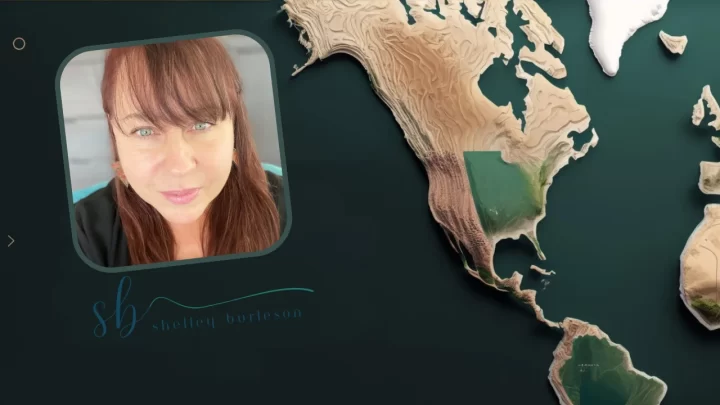This post may contain Amazon affiliate links which means, as an Amazon Associate, I may receive a small commission from purchases made through these links at no cost to you. I only recommend products I have personally used. To learn more, please see my privacy policy page.
Valentine’s Day, celebrated on February 14th, is more than a day of love; it’s a global phenomenon with diverse traditions. In the U.S., it’s marked by the exchange of cards, flowers, and chocolates. However, other parts of the world hold their own traditions close to heart. These variations highlight the cultural geography of Valentine’s Day.
Key Words
- Cultural Geography
- Global Traditions
- Globalization
Links to Recommended Reading & Activities
This exploration into the geography of Valentine’s Day reveals not just how love is celebrated, but how cultural exchanges and globalization influence and reshape traditional practices, making the day a unique blend of the universal and the local. Learn about the unique customs, fascinating history, and geographical spread of this day of love and friendship. Read on…
Key Takeaways
- Universality of Love: Love is a universal emotion celebrated across the globe, but the traditions, customs, and practices surrounding its celebration are incredibly diverse, reflecting the cultural and geographical landscapes of different societies.
- Cultural and Geographical Respect: Understanding and respecting the cultural and geographical differences in the celebration of love is crucial. It enriches our perspective, allowing us to appreciate the many ways in which love is expressed and celebrated around the world.
- Sustainable and Inclusive Celebrations: The movement towards more sustainable and inclusive ways of celebrating love, such as focusing on friendship, self-love, community service, and eco-friendly practices, highlights a growing consciousness about the environmental and social implications of our celebrations. This shift underscores the importance of mindful expressions of love that honor both our shared humanity and our responsibility towards the planet.

Valentine’s Day: Love without Borders
Valentine’s Day, universally recognized as a day of love and affection, has a rich history and tradition that spans centuries and continents. Originating from ancient Roman rituals, the day has evolved from the feast of Lupercalia, a festival of fertility, into the celebration of Saint Valentine, a figure shrouded in mystery and romantic legend. Over the years, February 14th has transformed into an occasion where lovers express their affection with gifts, cards, and gestures of love. However, the essence of Valentine’s Day extends beyond the confines of romantic love, embracing a broader celebration of love in its many forms.
The geographical location plays a pivotal role in shaping how Valentine’s Day is celebrated, giving rise to a diversity of traditions that reflect the cultural, social, and historical nuances of different regions. From the exchange of handwritten notes in some countries to the gifting of chocolates and flowers in others, the ways in which love is expressed vary widely across the globe. In some cultures, the day also encompasses the love between friends and family members, broadening the scope of celebrations to include a wider community of relationships.
This introduction to the geographical aspects of Valentine’s Day invites readers on a journey to explore how this day of love is uniquely celebrated around the world. It highlights the interplay between local customs and global influences, revealing how geography and culture converge to shape the traditions and practices of Valentine’s Day. As we study the varied expressions of love across different landscapes, we uncover the universal threads that connect us all in the celebration of love, affection, and human connection.

Origin and Spread of Valentine’s Day
Valentine’s Day’s roots can be traced back to the ancient Roman Empire, where it began as the festival of Lupercalia, celebrated from February 13th to 15th. This festival, which welcomed spring, was filled with fertility rites and the pairing of women with men by lottery, a far cry from the modern day’s romantic connotations. As Christianity spread throughout the Roman Empire, attempts were made to Christianize these pagan celebrations. Around the 5th century, Pope Gelasius I replaced Lupercalia with St. Valentine’s Day, celebrated on February 14th. However, the connection between St. Valentine and romantic love seems to have been a later addition, influenced by the medieval belief that birds began their mating season on this date.
The spread of Valentine’s Day through Europe during the Middle Ages added layers of romantic tradition to the day. In England and France, it was commonly believed that February 14th marked the start of birds’ mating season, which contributed to the idea that it should also be a day for human romance. By the 15th century, it had become customary for lovers to exchange love notes and call each other their “Valentines.” The practice of giving flowers, sweets, and other gifts as expressions of love began to take shape during this time.
The role of globalization in the 19th and 20th centuries was pivotal in transforming Valentine’s Day from a collection of scattered, local traditions into a global phenomenon. The industrial revolution, coupled with the rise of global trade and improvements in postal services, made it easier to exchange Valentine’s cards and gifts, turning it into a widespread practice. Commercialization played a significant role, with companies like Hallmark Cards in the United States beginning to mass-produce Valentine’s Day cards in 1913. This period marked the transition of Valentine’s Day into a significant cultural and commercial celebration, observed across many parts of the world.
The spread of Western media and culture through films, television, and the internet in the late 20th and early 21st centuries further cemented Valentine’s Day’s status as a global celebration. Today, it is recognized and celebrated in various forms around the world, from the Americas and Europe to Asia and Africa, each adding its unique twist to the celebration of love. The evolution of Valentine’s Day from a pagan festival to a global day of love is a testament to the enduring appeal of love and the human desire to celebrate it, transcending geographical, cultural, and historical boundaries.

Valentine’s Day Around the World
As Valentine’s Day approaches each year, its celebration takes on myriad forms across the globe, reflecting the rich tapestry of cultural traditions and societal values. From the commercialized exchanges of cards and gifts in North America to the deeply ingrained customs of friendship in Latin America, the day of love is both a universal and uniquely local phenomenon. This section explores the geographical diversity of Valentine’s Day, highlighting how various regions commemorate this day dedicated to love.
North America: Here, Valentine’s Day is heavily commercialized, characterized by the exchange of cards, chocolates, and flowers. In the United States and Canada, this day is a significant occasion for expressing love through material gifts, with schools, offices, and communities participating in the festivities. The commercial aspect is undeniable, with the day generating substantial economic activity through the sale of greeting cards, sweets, and floral arrangements.
Latin America: A unique feature of Valentine’s Day in Latin America, particularly in Mexico, is the inclusion of friendship in the celebrations. Known as “Día del Amor y la Amistad,” it is a day to celebrate both romantic and platonic relationships. Mexicans exchange gifts and affection not just with their romantic partners but also with friends, highlighting the cultural value placed on broader social bonds. Schools and workplaces often organize activities that encourage the sharing of tokens of appreciation among friends, reinforcing community ties.
Europe: The celebration of Valentine’s Day in Europe varies greatly, with each country adding its cultural flair to the occasion. In Italy, couples enjoy romantic dinners, often accompanied by the exchange of gifts. France, known for its romantic ambiance, sees towns like Saint-Valentin becoming hubs of love-related activities, including the exchange of love letters and floral gifts. These traditions underscore Europe’s historical romance with love and affection.
Asia: Asian countries offer a distinct twist to Valentine’s Day celebrations. In Japan, the tradition involves women giving chocolates to men on February 14th, with a reciprocal gift-giving day called White Day observed on March 14th. South Korea expands the concept with multiple love-related holidays, catering to both couples and singles, thus integrating the celebration into the fabric of society in diverse ways.
Africa: The adoption of Valentine’s Day in urban areas across Africa reflects a blend of Western traditions with local customs. Young couples partake in the global practice of exchanging gifts and romantic outings, while community events showcase the day’s burgeoning popularity across the continent. This fusion of customs highlights the global reach of Valentine’s Day, adapting to local cultures while maintaining the core theme of celebrating love.
The celebration of Valentine’s Day around the world showcases the universal appeal of love and the diverse ways in which it is celebrated. From the intimate exchanges between couples to the communal celebrations of friendship and love, the day transcends cultural and geographical boundaries, uniting people in a shared expression of affection. As we explore these global traditions, we are reminded of the power of love to bridge differences and bring people together, making Valentine’s Day a truly global celebration.

Cultural Significance and Geographic Variations of Valentine’s Day
The celebration of Valentine’s Day across different geographies is deeply interwoven with the cultural fabric of societies, each adding its unique hue to the canvas of love and affection. This global mosaic of Valentine’s Day celebrations is not merely a testament to the universality of love but also to the profound impact of geographical and cultural factors that shape its observance. These factors, ranging from economic conditions to social norms and historical legacies, play a crucial role in defining how Valentine’s Day is celebrated around the world.
Valentine’s Day is a reflection of the cultural zeitgeist of a society, molded by its historical narratives, economic conditions, and social structures. In countries with a rich tradition of literary and romantic arts, such as France and Italy, Valentine’s Day celebrations often emphasize grand gestures of love and elaborate expressions of affection, mirroring the countries’ historical association with romance. In contrast, societies with a strong communal ethos, like Mexico with its “Día del Amor y la Amistad,” extend the celebration beyond romantic love to include friendships, showcasing the cultural emphasis on broader social relationships.
The economic landscape of a region also significantly influences the nature of Valentine’s Day celebrations. In affluent societies, the day is marked by the exchange of expensive gifts and luxury experiences, reflecting the economic capability to indulge in such expressions of love. Meanwhile, in less affluent regions, the day may be celebrated with simpler, yet equally meaningful, gestures that emphasize emotional connection over material value.

Commercialization and Its Impact on Valentine's Day
The commercialization of Valentine’s Day has had a profound impact on local economies and global trade, turning the day into a major commercial event that rivals major holiday seasons in some regions. The demand for flowers, chocolates, and greeting cards spikes dramatically, supporting industries and businesses worldwide. For instance, the flower industry sees a significant portion of its annual sales around Valentine’s Day, with roses being shipped worldwide to meet the increased demand. This global trade in flowers has economic implications for countries like Ecuador and Colombia, which are major exporters of roses.
Similarly, the chocolate industry benefits enormously from Valentine’s Day, with the tradition of gifting chocolates driving sales in countries known for their chocolate production, such as Belgium and Switzerland. This period of increased consumption boosts local economies but also raises questions about sustainability and the ethical sourcing of ingredients.
The commercialization of Valentine’s Day has also led to a homogenization of how love is celebrated, with global marketing campaigns promoting a standardized set of practices and gifts. While this has facilitated the global spread of Valentine’s Day, it also poses challenges to local traditions and celebrations, potentially overshadowing regional customs with a more commercialized, Western-centric notion of the day.
In conclusion, the celebration of Valentine’s Day is a complex relationship between cultural, social, and economic factors that vary widely across different geographical regions. While the commercialization of the day has unified certain aspects of its celebration, it also highlights the diversity of expressions of love around the world. Understanding these geographical variations and cultural significances offers a richer, more nuanced perspective on Valentine’s Day and its role in contemporary society.

Critiques and Alternatives to Traditional Valentine’s Celebrations
While Valentine’s Day is celebrated by many around the globe as a day of love and affection, it has not been without its critiques, particularly concerning its commercialization and environmental impact. The day’s association with consumerism — through the purchase of gifts, flowers, and cards — has led to discussions about its sustainability and the broader implications for society and the environment. These critiques have spurred a movement towards alternative celebrations that emphasize more sustainable and inclusive expressions of love.
The commercialization of Valentine’s Day has been critiqued for encouraging excessive consumption and materialism, detracting from the day’s essence of expressing genuine affection and love. The environmental impact is also significant, with millions of cut flowers, often imported from far-off countries, contributing to carbon emissions. Furthermore, the production and disposal of greeting cards, packaging for chocolates, and gifts add to the environmental footprint of the celebration.
Alternative Celebrations
In response to these critiques, a variety of alternative celebrations have emerged, focusing on friendship, self-love, and community service. These alternatives seek to reclaim the spirit of Valentine’s Day by promoting more meaningful and sustainable practices.
Friendship and Galentine’s Day: Originating from popular culture, Galentine’s Day is celebrated on February 13th as a day to honor friendships, especially among women. This celebration has gained popularity as an inclusive alternative that broadens the focus from romantic love to platonic relationships, emphasizing the importance of friendship.
Self-Love: Recognizing the importance of self-care and self-appreciation, some choose to celebrate Valentine’s Day by focusing on self-love. This can involve practices like meditation, treating oneself to a favorite activity, or simply taking the day to rest and reflect. This approach promotes mental and emotional well-being, emphasizing that love starts with oneself.
Community Service and Acts of Kindness: Another alternative celebration involves giving back to the community or engaging in acts of kindness. This could include volunteering at local charities, organizing events to support a cause, or simply performing random acts of kindness for strangers. This perspective on Valentine’s Day highlights the love and care for the broader community, promoting a sense of solidarity and compassion.
Eco-Friendly Celebrations: In response to environmental concerns, some opt for eco-friendly celebrations that minimize waste and carbon footprint. This can involve gifting potted plants instead of cut flowers, making handmade cards from recycled materials, or choosing gifts from local artisans to support the local economy and reduce transportation emissions.
These alternatives to traditional Valentine’s Day celebrations offer diverse and inclusive ways to express love, emphasizing the value of personal connections, community welfare, and environmental sustainability. By adopting these practices, individuals and communities can celebrate love in its many forms, while also addressing the critiques of commercialization and environmental impact associated with the day.
Wrap Up...
As we journey through the various traditions, critiques, and alternatives surrounding Valentine’s Day, it becomes evident that the celebration of love is a universal phenomenon, albeit one that is manifested in incredibly diverse ways across the globe. From the commercial exchanges in North America to the communal celebrations of love and friendship in Latin America, and from the eco-conscious alternatives to the deeply rooted traditions in Europe and Asia, each practice reflects the cultural and geographical nuances of its people. This diversity in celebration is a testament to the multifaceted nature of love itself — a force that transcends boundaries, languages, and traditions, uniting humanity in its shared expression.
The exploration of Valentine’s Day around the world also underscores the importance of understanding and respecting these cultural and geographical differences. Recognizing that love can be celebrated in myriad forms allows us to appreciate the richness of human expression and the varied ways in which societies choose to honor this universal emotion. It challenges us to look beyond our own traditions and to embrace a more inclusive perspective on love, one that acknowledges and celebrates its many manifestations.
Moreover, the movement towards more sustainable and inclusive ways of celebrating Valentine’s Day — whether through friendship, self-love, community service, or eco-friendly practices — highlights a growing consciousness about the broader implications of our celebrations. It reminds us that at the heart of Valentine’s Day is the opportunity to not only express love but to do so in a way that is mindful of our social and environmental responsibilities.
In conclusion, Valentine’s Day, with its global traditions and practices, invites us to reflect on the universality of love and the importance of celebrating it in ways that honor both our differences and our shared humanity. As we navigate the complexities of modern life, let us cherish and uphold the diverse expressions of love, fostering a world that values compassion, understanding, and respect for all.


